Bird Watching
-A real story by Dr.Surya Prakash
I was living very peacefully & comfortably in the topmost ventilator of a factory in Rohini New Delhi, India with my family.Me and my husband had raised so many young ones in this factory without any troubles and they all are living independently I can’t say
where and how?
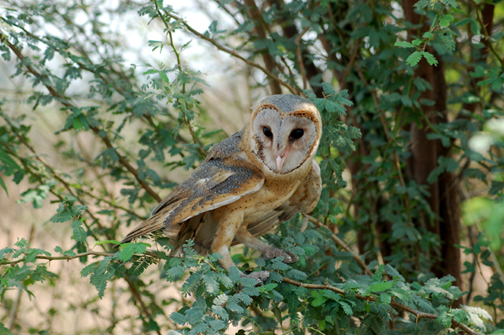
From The Ventilator
Well! We basically prefer to stay inside or outside of human habitations that includes abandoned buildings dead trees ,artificial nest boxes and also love to stay at human worship places sometimes and hence are also known as ‘Church Owl’.
At some places we are considered as a symbol of ‘LOVE’ because of our heart shape face which is true But at the same time we are called as ‘Ghosts’ as well, and are considered as bad omen but we know we are the harmless avian friends of human society and help
them in all possible way by controlling the harmful pest for free (One study by the Connecticut Department of Environmental Protection reports a barn owl family will eat more than 1,000 rats and mice in one nesting season.)
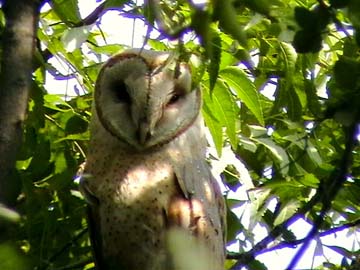
Heart Shaped Face – A Symbol of Love
I can’t forget that chilly and misty horrifying night of December 2009. When the owner of the factory where we were living,was talking to all his workers and we all were watching them from our home (ventilator)from the top. My husband had gone to fetch food
for our six young ones.
I was shocked to hear when the factory owner warned his workers. ‘My business is going in loss I have consulted one priest(tantric) who had inspected my factory and has explained me the cause of loss in business. It is just because of these “Ghost Owls” .
I recalled in 2007 when one of our relative at Pune from our own community(Barn Owl ) was brutally killed and young ones were tortured their 4 chicks were caught and their legs were tied mercilessly with strings and were thrown out of the factory to die.
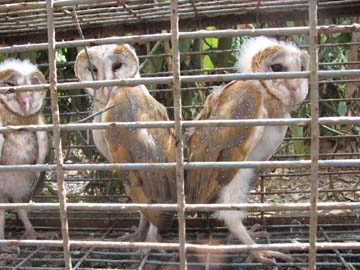
Rescued Barn Owls at Pune
While I was dreaming all about future and past I just forgot the present and suddenly I heard a sound of a gun fire and next moment I was on the floor in a pool of blood taking my last breath and helplessly watching my six chicks who were crying for the help.
Within a moment my soul left my physical body and flew to join my family I was able to see them but, they were not , as I was heavenly abode.
The next thing which that factory owner did was still horrifying he caught my 6 chicks and tied their legs and threw them out in a jungle near a drain to die or become pray of any beast. In the mean time my husband , (father of the chicks)returned home
with a big rat and started looking for all of us. He placed that rat on the nest and started calling me and chicks. I could see the pain in his eyes and worry for not locating us. Our young ones were shivering in the cold and were helplessly crying .It takes
nearly 2 months for chicks to mature and even after that they stay with us for two months to get the training of hunting and protecting themselves .
The silence and darkness of the night was very scary for young ones I was waiting and watching the live telecast of death of all my little ones like the blind and helpless Dhritrastra (Father of Karavas) who heard the story of killing of all his 100 sons in
Mahabharata from Sanjay.
As all the employees of that factory owner were tight lipped under the pressure of their master and I was sure that none of them will save my chicks as they all had fear of losing their job.
But all humans are not INHUMAN some have a beating heart for others too. One of the workers secretly made a phone call next day in early morning to my friend Avijit and explained him about the ‘dramai n real life’ without disclosing his identity. It was enough
. My soul disappeared from the cruel world after seeing one helping hand (Mother owl slept forever) . I received a phone call soon after from my friend who had already picked up those helpless chicks in a very bad condition .
I explained to my friend to give them warmth immediately as they were under frost injuries and keep them in a big wooden box by the time I reach there. After reaching there my friend told me that he had fed them minced meat also as directed by me through
intubation.
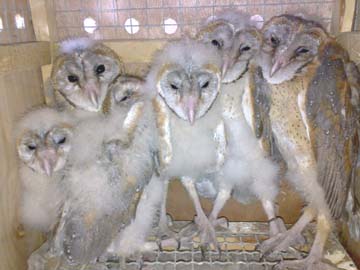
After Recovery from Frost Injuries
Next day owlets were on their own feet and we were happy to save them. Believe me these chicks were continuously calling/crying (hissing) throughout the night and day .
May be waiting for parents to return or for something else or may be because of shock they had undergone or because of pain. We were unable to diagnose the cause. But this was sure that all is not well. We fed them regularly for a week and they ate well.
As the house of my friend was far off from my house so it was difficult for me to visit him every day but I was in touch with him over phone. I was shocked when I called my friend one day and came to know that the smallest chick has passed away and same night
another chick also died.
We separated them according to size to prevent in-fight. It worked fine and their health improved .But within next 48hours all of them died.
It was a real shock for all of us and we all are feeling very sad but we realize that not always humans can be foster parents but we have the satisfaction that we tried our best to save them . They lived with us for 10 days leaving behind some good memories
and a message that Owls must not be ill-treated by civilized human society. May be their heavenly abode mother wanted them to come to her… for peace… God only Knows… I remember a sher of famous poet
“Log toot jate hein ek ghar bananen mein,
Woh thakte nahin ,Bastiyan jalaneinmein”
C@SuryaPrakash,JNU
|
Burning Issues
-Suhas Kumar
(Contd.from last month)
Securing dispersal areas and corridors: Why most shy away from the real issues:
I can understand the reason for every one who matter shying away from real issues that are critical to conservation of tiger - the task of securing areas other than already declared PAs appears politically incorrect as well as harmful
to many because people who live in and around PAs have become wary of wildlife conservation as they don't see any stake for themselves in conserving wildlife. The original plan of GoI to elicit public support was explained in a document - "Eliciting
Public Support for Wildlife Conservation" written almost 27 years ago, in early eighties, but very little was done towards its implementation. Besides, the financial inputs required to implement a meaningful eco-development programme in the buffer
areas for the benefit of forest side communities is going to be enormous and that kind of money is apparently not available for such a 'low priority task'.Within Forest departments there is always a war going on - those who work in wildlife areas are pariahs,
non-elite. Today, it is almost impossible to find an officer who willingly consents to undergo wildlife training or join a wildlife area. The present atmosphere of distrust towards wildlife managers is going to be counterproductive; if this continues, I
am afraid that the hitherto devoted officers, who deliberately chose a career in wildlife management, would soon like to move in other directions.
The officers managing the non-PA forests were never made to feel responsible fort igers and other wildlife. Today the tiger has become a dangerous thing to them- tiger is hot potato that can burn their fingers and dislodge them from their
commands or may lead to their suspension. And, therefore, the managers of non-PA forests have now begun to avoid supporting reports of movements or presence of tiger within their jurisdiction.
On the other hand the wildlife personnel who work in remotest of areas braving harshest of conditions and without incentives are further marginalized by media, and public breathing down their neck. I know of no other civilian set up where
field personnel are subjected to such hardships. Their plight was amply highlighted in the report presented by Subramaniam committee to MoEF in 1993. This report was prepared after the committee met and discussed with large number of field
personnel, park mangers, scientists and NGOs across the country. The committee gave several excellent recommendations that were only sparingly implemented. Today I am sure there may be only a few who would wish to acknowledge the existence of this report.
In such a grim scenario only following two options are available:
A. Secure Dispersal areas and corridors
-
Garner political courage and financial resources to support a well planned eco-development programme in villages that are dependent of PAs, dispersal areas and corridors.
-
Implement well conceived awareness programmes to win public support and participation of forest side communities in protecting dispersal areas and corridors, outside major Natal areas (PAS)
-
Declare and manage buffer zones as areas to accommodate nistar by local people and as dispersal habitats for wild animals.( pl don't make the buffer zones another PA - the amended Wildlife Protection Act has just done that)
-
Enforce a land use policy that supports protection of potential wildlife dispersal areas around tiger reserves (stop land-uses such as mining, hotels, industries that degrade its use as habitats and movement corridors by wild animals).
-
Make managers of territorial forests as responsible as the protected area managers and equip them to combat wildlife crime.
-
Provide funds to territorial divisions to implement prescriptions to enrich potential habitats within forest areas under their jurisdiction.
-
The Tourism industry that makes huge profits from protected areas must become partners in supporting conservation programmes financially and also through overt actions by adopting conservation measures in their businesses ( location of facilities,
design, water and energy use, local employment, eco-development inputs and so on)
If the above strategy sounds unachievable and too ambitious and risky, follow the one below:
B.Fencing off tiger reserves and other tiger bearing habitats
1.Fence off the tiger reserves and other tiger bearing habitats
2. Ensure population management through management interventions - translocation of surplus populations to depleted areas.
3.Ensure gene exchange through aerial corridors - exchange of males among parks.
4.Create and fence off new suitable areas for preservation of tiger.
5.Earn dollars from elite tourism
I am sure the second option will appeal to most. Though, I would any day prefer the first option.
Concluded
Watch a clip on Kanha Natonal Park below
|
Corporates and Environment
-Dr.Susan Sharma
In our ezine of January, 2006, we had published an article about ISB, written by Ragoo Rao who was instrumental in landscaping the campus when it started.
That the landscape will define this premier school and my first visit to the place will remain with me forever for the sheer beauty of the environs, is something I did not expect. I visited the School in April, 2010 to attend the Convocation of the Class of
2010.
On a hot afternoon resting in the A.C Room of the Executive Guest House our son had booked for us, a huge butterfly flitting about outside the window, caught my eye. The Crimson Rose, my first sighting of this butterfly, thrilled me no end. I showed the picture
I clicked to my son. “I have seen it outside my hostel room as well”, he said.
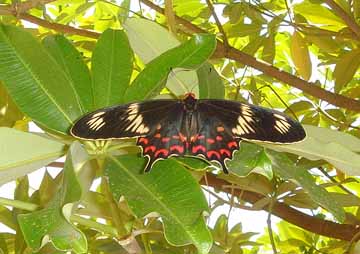
Crimson rose is a large swallowtail butterfly. The butterfly was seen resting on local trees. The campus did not have any lantana bushes that I could see but the abundance of other flowers must be providing enough nectar for the butterflies.
During the morning walk through the campus the next day, I could see the meticulous planning that had gone in landscaping the area.
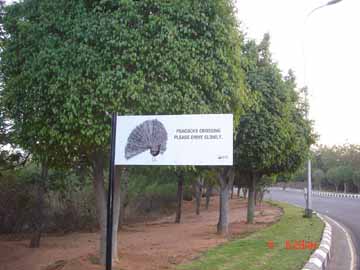
The main avenues were lined with ficus bushes but just behind were rows and rows of local trees and bushes where birds and butterflies made merry. In the span of half an hour I saw peafowls, a crow pheasant, green bee eaters, wag tails, paddy birds, bul buls
, mynahs, warblers, sun birds, tailor birds ….a galloping brown hare …
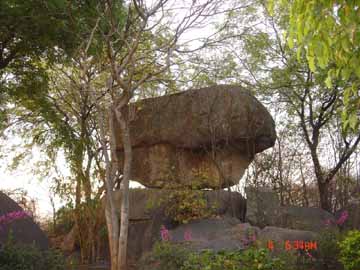
The beauty of the place cannot but create an impression on the future businessmen and executives.
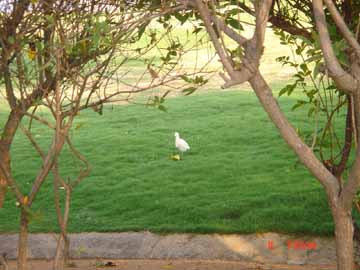
Two students from the 2010 batch have created a cartoon series called “The Cold Call”. A humorous take ( loosely on the lines of the Dilbert Comics) on the One year integrated course by two peafowls ( the most common and one of the numerous of the bird species
seen around). Here is a humorous clip. To see more, visit
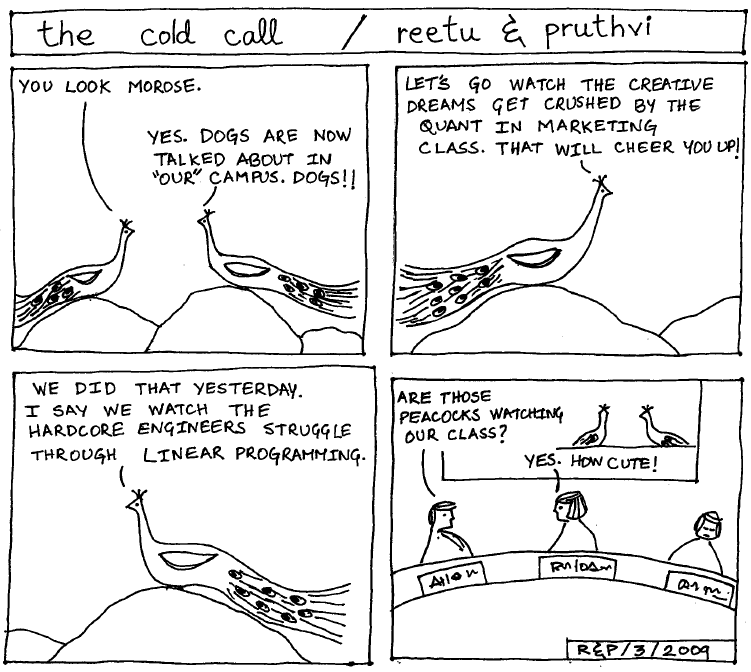
http://thecoldcall.blogspot.com/
|
Eco-travel
This is ASSAM!
-Russell Crisante' Fernandes
Our previous trip to Assam met with the bitter disappointment of Kaziranga closing early for the monsoon. And while the splendor of Manas did it's bit to raise our levels of contentment, something was amiss as Kaziranga in a way represents the true face of
Wild Assam. This time however, we planned our trip for the right season and stayed clear of the vagrancies of the rainfall in the North-East.
The long drive from Guwahati was broken with some beautiful views of tea gardens, meadows and occasional patches of towering trees. The widening of the national highway did take some sheen of the sights, but the sights on either side of the road were too good
to nurture a frown. We reached our resort, the comforting Wild Grass Lodge, well past nightfall and retired early for the night. The morning begins well before 5am in these parts for the true nature lover and as the saying goes, it pays to be an early bird.
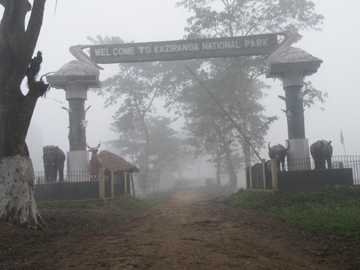
On our first morning, we opted to start the day with the highly recommended Elephant Safari at the Baghori range. Kaziranga has three main tourism zones , Baghori (Western) , Kohora (Central) and Agaratouli (Eastern). Of these, Elephant Safaris are carried
out in the western and central ranges twice in the morning at 5 and 6 am respectively. The saddles on the Elephant are reminiscent of an old school bench, where you jostle with your mate for elbow room. A point to note is that in the Baghori range, the Elephant
safaris are carried out by a private operator and the Forest Department handles all the rides at Kohora. Some additional information to consider is that foreign nationals are permitted to undertake the Elephant rides only at the Baghori range.
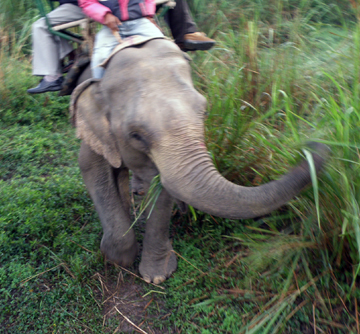
There is nothing like entering the jungle on the highest seat available, that too a really sturdy one. It is also probably the 'Greenest' way to move, since your vehicle works on 100% plant fuel that it isn't shy to pick up along the way. Occasionally, the
exhaust products from the vehicle can leave a foul odor. But it provides food material for a variety of insects, birds and small animals, so 4WD lovers will have to really come up with a good reason to top this mode of transport. An added bonus of traveling
on Elephant back is the proximity that it affords for close animal and bird encounters. Hog Deer give you that one extra second before scampering off and Rhinos or Wild Buffalo will think twice before giving you a dose of their famous bad attitude.
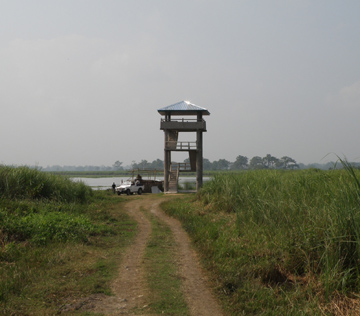
While we were unable to fit an Elephant Ride in the Kohora range into our itinerary, it is also recommended as a resident herd of Barasingha or Swamp Deer are present right near the boarding point. For those that prefer the rattle and roll of a Gypsy, there
is no reason to be disappointed. Most of the trails in all the ranges are in excellent condition. Apart from a few low level streams at Kohora, the journey through all 3 zones could've fooled me into believing that we were on the highway to Green Heaven. Except
of course, for the presence of Rhino blockades instead of Angels with harps. It is important at all times to remember who has the right of way here. It is not just the massive Rhinos, Elephants and Wild Buffalo that deserve our respect, but even the smallest
denizens of the park. Thick foliage around the corners means that it is recommended that you save the burning of rubber for another track and plan your exit time accordingly, so that your driver does not have to race like a bat out of hades to make it back
to the gate without being penalized.
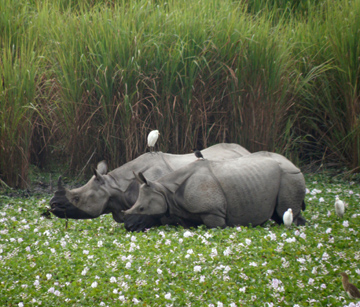
To summarize what to expect from each of the zones, purely in terms of landscape, here is a brief about the 3 major ones :
Kohora : Being the central and the largest of all the zones, it is definitely recommended that you cover this one during the day to have enough time to go around the entire expanse. The views of the river with Roofed Turtles and wading birds is an amazing right.
There are watchtowers overlooking the swamps and one can easily see all of Kazirangas famous herbivores with some luck in a single drive through Kohora.
Baghori : One of the smaller zones, it is located closer towards Guwahati and offers similar terrain to Kohora. The real treat here is the presence of strategically placed watchtowers and a stop here at dusk may reveal some beautiful moments. Another feature
of the drive along Baghori is the ability to view a plethora of wildlife on the opposite banks by parking your vehicle at different spots during the drive. Large numbers of Hog Deer graze peacefully with their amour plated bodyguards and also the muscular
bovines in strong numbers. These are sights more reminiscent of Africa and made me apply the TIA (This Is Africa) phrase in a different, but equally compelling sense : This Is Assam.
Agaratouli : The Eastern range has the least number of tourist facilities and on some days, you could find your vehicle with none other for company. This, provides a charm of a different kind and is a recommended drive at least once on your trip to Kaziranga.
This is also probably the best zone for birdwatching opportunities while mammal sightings, although few, are often dramatic. As with Baghori, making stops at different spots with your vehicle and observing the numerous bird species is an experience of a lifetime.
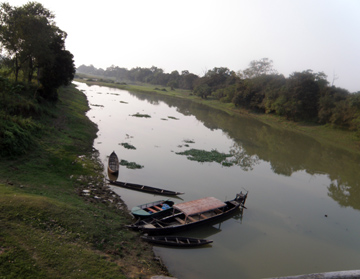
( The author, Russel Fernandes is a corporate trainer by profession and can be reached at
|
Urban Wildlife
-Arun Dube
Birds require food, water and an adequate number of nesting places for them to remain in a particular garden.
Much to the consternation of my gardener, I have given him strict instructions that bushes and trees in the garden are not to be pruned so that birds can safely build their nests in them.
I place a large earthen bowl of millet on the terrace of my house and also two large bowls of water, one on the terrace and the other in the shade of a ‘jamun’ tree in the garden. I have been doing this for years and refill the bowls daily, sometimes even twice
a day. These bowls have drawn birds to the garden over the years and it is always a joy to watch them.
Regular, daily visitors to the garden are peafowl, partridges, doves, pigeons, sparrows, rose-ringed parakeets, plum-headed parakeets and mynahs. During the winter months, a large flock of rosy starlings takes up residence in the garden from October to early
March, before flying off. Hoopoes also come during winter to the garden. There are some small birds which are permanent residents. They are insect eaters and are mostly to be seen either on the lawn or in the creepers and hedge. The more unusual ones are the
Oriental Magpie Robin, which is a small, predominantly-black bird with white streaks, and the Ashy Prinia.
I am lucky to get interesting avian visitors like the Hornbill, Golden Oriole, Greater Coucal and the Flameback woodpecker regularly. Sometimes, I find Coppersmith Barbets and Spotted owls in residence in the old branches of the two jamun trees in the garden.
While the coppersmiths announce their arrival quite loudly, the owls are more discreet and make their presence known only at night.
One extremely unusual resident at present is a White-breasted waterhen, which has taken up residence in some bushes near a lotus-filled pond in the garden. At first I thought it had lost its way but it has been staying in the garden since February this year
so I suppose it finds the garden to its liking. It is extremely wary of people so I have to watch it from a distance. It generally feeds on tadpoles and small water insects in the pond. It is not injured and sometimes flies from the lawn to the tops of trees
in the evenings.
This I consider an appreciation of a true garden.
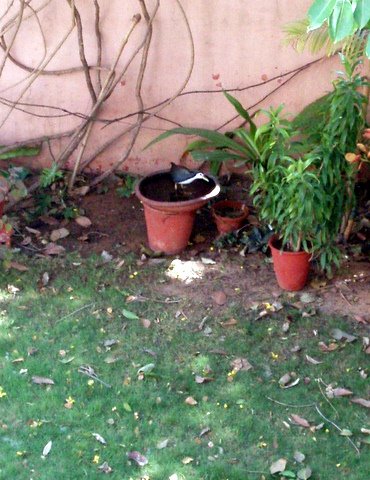
(Arun Dube is a resident of Jaipur and can be contacted at dubearun@gmail.com)
|
Wildlife Photolog
-Paul McDougall
Kenya has many beautiful natural wonders. It is teeming with wildlife. It has many National Parks and Reserves including Lake Nakuru National Park, Amboseli National Reserve, Tsavo National Park, Samburu National Resaerve and the most famous Masai Mara National
Reserve.
All of the big 5 are found in Kenya. The big 5 are so named because they were considered the most challenging animals to hunt in colonial times and also the heads of these animals made the most impressive and sought after trophies. The big 5 are Lions, Leopard,
Elephant, Rhino and Buffalo.
The Lion (Panthera leo)
The Lion is the national animal of Kenya, it features on all Kenyan coins and a lion’s head is the watermark on all Kenyan Shilling notes. It is the largest of all African carnivores. The African Lion is larger and more social than its Indian relative. Lions
in Tsavo received fame for being man-eaters. From 1895-1901 when the Mombassa to Kampala railway was being built, all of the rolling stock and labour were imported from India – 2 lions systematically killed 28 indian workers and unknown numbers of local people
when the construction reached the area of Tsvo in 1898, they were eventually killed by the man in charge of the construction Lt . Col J.H. Patterson.
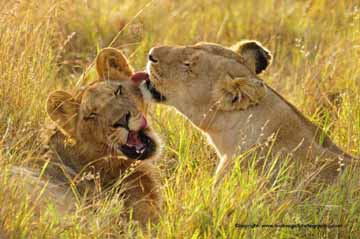
The male lion is larger and generally has a mane (although males found in Amboseli and Tsavo generally do not). Female lions are smaller and are without the distinctive mane, this is a genetic feature as the females do most of the hunting and the mane would
get in the way. Lions live in prides of up to 40 (Masai Mara), pride numbers generally depend on the variety and availability of food. Prides are made up of a base of females with the males being transient and usually having short tenures with a pride, there
are always younger and stronger males looking to take over the pride. When a male or males take over a pride the first thing they will do is kill all of the young cubs, this then means the females will come in to oestrus and be ready to mate again thus ensuring
that the new males genes are present in the pride offspring.
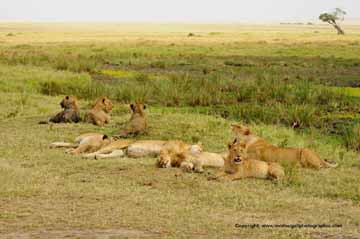
Lions mate for 13 days – the male and female often leave the pride whilst they are mating, they can mate for up to 72 times a day and copulation lasts around 20-30 seconds a time. When the female gives birth she leaves the pride temporarily and will return
to the pride 4- 8 weeks later with her new cubs. Lionesses generally give birth to 3 cubs, but it ranges between 1 and 4. Lions are very social cats and often greet each other by rubbing noses and cheeks; they also have many distinct sounds and roars which
are all important in the communication process. Lions use communication to advertise their presence, locate pride members, strengthen social bonds and to intimidate rivals.
Lions spend up to 18 hours a day resting and sleeping. Lions eat a variety of prey species and are known to scavenge a meal sooner than hunt for one. When lions do hunt they hunt in groups with the females doing most of the hunting, they generally will hunt
an animal big enough to feed the whole pride with zebra, wildebeest and even buffalo being favourite prey species. Lions can still be seen in large numbers in Kenya, all of the larger national parks and reserves will have them. Lions are however facing the
same struggles as many other big cats and the number of lions in Kenya is dropping due to habitat destruction and encroachment by humans. The best place in Kenya to see these beautiful big cats is Masai Mara National Reserve, especially between July and October
when the great wildebeest and zebra migration enters the reserve.
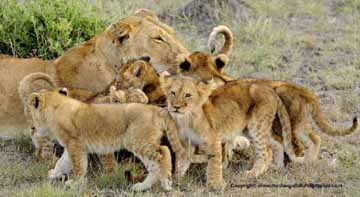
I have had so many amazing moments photographing lions, I really cannot choose a favorite one, there have been so many for so many reasons. Maybe it would be the big male lion roaring on a cold evening in Masasi Mara , and listening to this deafening noise
and seeing the breath come from its mouth. Maybe it would be the 3 lionesses with the 11 young cubs walking right past our vehicle full of confidence and purpose, Probably my best lion moment though was in Botswana, I was staying at a luxury bush camp and
helping out there for a couple of weeks, one night I spent in the guesthouse and was visited by a huge pride of lions, they had come to drink from the pool of water right outside my downstairs bedroom window. I leant on the window sill and watched them drinking
through the mesh window, when all of a sudden one of the lionesses put her paws on the window ledge and looked right at me, I didn’t move for what felt like ages – just looking at her and having her look at me. I could feel her warm smelly breath on my face.
I think that moment was what started my love and fascination with lions.
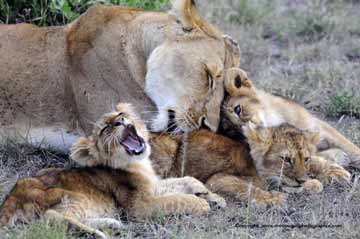
Masai Mara will always be my favorite place for Lions, but one pride in particular became my pride, they were actually called Pauls pride by our company, the reason being was that I had photographed them for over 5 years, young cubs, several sub-adult cubs,
the 3 impressive females who were very successful hunters and the big male who had held his territory for a long time. The pride became my favorite and I spent many hours sat with them photographing and watching them. I was compiling a photo journal of this
pride and the idea was that they would form the basis on a book that I would write about Masai Mara. Unfortunately in April 2009 the whole pride was killed, they had apparently been killing Masai cattle who had been brought in to the park to graze during a
period of severe drought, allegedly they fed on a poisoned cow carcass, the whole pride wiped out on one sad day. When I heard the news it really was like loosing a good friend, not to mention 5 years of photography that at the time I felt had been wasted.
I visited my old prides territory not long ago and there is now a new pride in that area, so now I plan to document this pride, and hopefully still tell their story in a book.
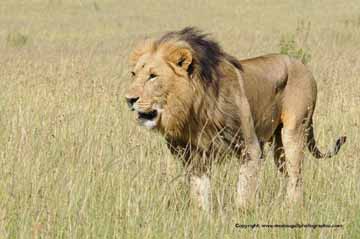
Want to know more about Kenya?
Read
http://wanderwithjo.com/to-kenya-with-love/
|